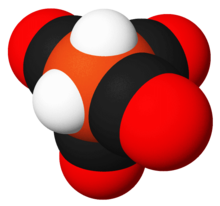Iron tetracarbonyl dihydride

| |

| |
| Names | |
|---|---|
| Preferred IUPAC name
Tetracarbonyldihydridoiron(II)[citation needed] | |
| Other names
Iron tetracarbonyl dihydride, tetracarbonyldihydroiron
| |
| Identifiers | |
3D model (
JSmol ) |
|
| ChemSpider | |
PubChem CID
|
|
| |
| |
| Properties | |
| FeC 4H 2O 4 | |
| Molar mass | 169.901 g mol−1 |
| Appearance | Liquid (at -20 °C) |
| Melting point | −70 °C (−94 °F; 203 K) |
| Boiling point | −20 °C (−4 °F; 253 K) (decomposes) |
Except where otherwise noted, data are given for materials in their standard state (at 25 °C [77 °F], 100 kPa).
| |
Iron tetracarbonyl dihydride is the
Preparation
Iron tetracarbonyl dihydride was first produced by Hieber and Leutert from iron pentacarbonyl, which is first converted to HFe(CO)−
4:[2][3]
- Fe(CO)5 + 2 OH− → HFe(CO)−
4 + HCO−
3 - HFe(CO)−
4 + H+ → H2Fe(CO)4
Since the compound is thermally labile and sensitive to light, ideal conditions in 1930's Munich called for winter nights. The early method was called the "polar night synthesis."
As recommended by Hieber and Leutert, the compound can be purified by trap-to-trap distillation.[1][4]
Structure and properties
In iron tetracarbonyl hydride the Fe(CO)4 group has C2v molecular symmetry with a geometry intermediate between octahedral and tetrahedral. Viewed as an octahedral complex, the hydride ligands are cis. Viewed as a tetrahedral Fe(CO)4 complex, the hydrides occupy adjacent faces of the tetrahedron.[5] Although the structure of tetracarbonyliron with the hydrogen atoms bound as a single H2 ligand has been proposed as an intermediate in some rearrangement reactions,[6] the stable state for the compound has the two atoms as independent ligands.[7]
Reactions
Iron tetracarbonyl dihydride undergoes rapid ligand substitutions by phosphorus ligands:
- H2Fe(CO)4 + PPh3 → H2Fe(CO)3PPh3
The substitution mechanism is proposed to entail transient formation of a 16e− formyl intermediate.[8]
H2Fe(CO)4 has pK1 of 6.8 and pK2 of 15.
- HFe(CO)−
4 + H2O → H2Fe(CO)4 + OH−
See also
- Potassium tetracarbonyliron hydride
- Collman's reagent
Further reading
- Tsai, J.-C.; Khan, M.A.; Nicholas, K.M. (1991). "Reduction of Coordinated Carbon Dioxide by Transition-Metal Hydrides". .
- Farmery, K.; Kilner, M. (1970). "Substitution reactions of dihydridotetracarbonyliron". Journal of the Chemical Society A: 634. .
References
- ^ ISBN 9780470132333.
- S2CID 791569.
- ISBN 978-3527306732.
- .
- .
- PMID 11225102.
- .
- .
- .
- .
- Mingos D.M.P.2007. Comprehensive Organometallic Chemistry III From Fundamentals to Applications. Elsevier Ltd.
